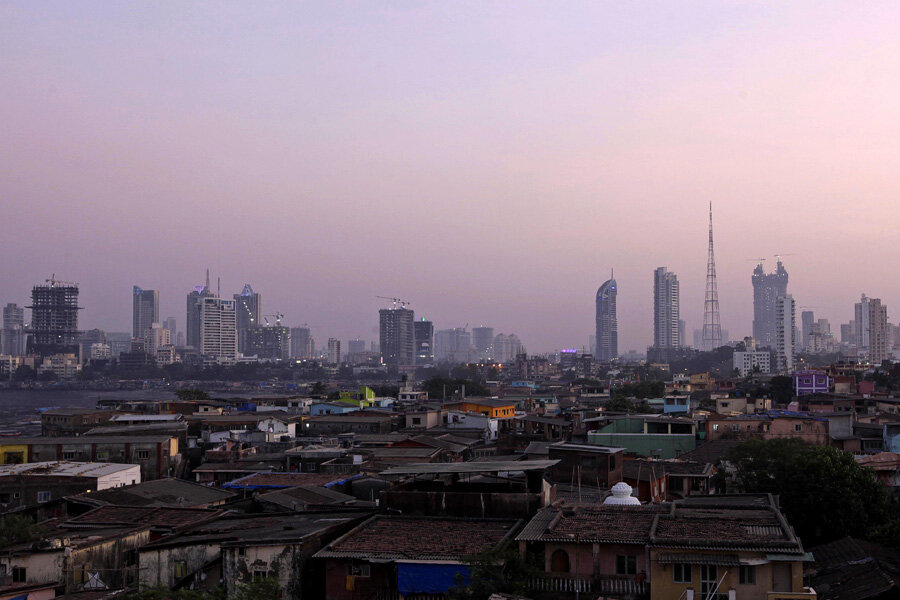In Indian election trail, a new brand of 'rurban' voters
Loading...
| Nagpur, India
The main drag in Kanhan, a small settlement close to the coal mines of central India, is lined with small restaurants, auto repair shops, and political banners. Hawkers sell scarves to young men on motorbikes who wrap their faces against the burning heat and dust.
Blue-collar jobs are thin on the ground. But that could change: In February, the state government acknowledged on paper what was already true in reality: it gave Kanhan, a village of 20,000, the status of a town – a move that will bring more public money, infrastructure, and commerce to the area.
The beneficiaries are young men like Ishwar Karemore, whose tapered jeans and short spiky hair belie his rural roots. He commutes from his farm in Kanhan to a vocational training center an hour away in Nagpur, a city of 2.5 million people in Maharashtra. Voters are going to the polls today, one of 12 states voting in India's multistage national parliamentary election that runs through May 12.
Living in a town will be a step up from a village, and should boost Mr. Karemore's career prospects. “We can’t compete with Nagpur kids, their libraries and newspapers and broadband coverage,” he says.
India lives in its villages, said Mahatma Gandhi, and this is still largely true. But economic shifts and greater connectivity are urbanizing many rural areas in a way that may be creating a new kind of constituency: one that is neither classically urban nor rural, but a hybrid “rurban.”
Blurred voting lines
The trend could reshape Indian politics and its rural-urban divide. Traditionally, the centrist Congress Party, which heads the incumbent government, has polled well with the rural poor and minorities, while the opposition Bharatiya Janata Party appeals to the urban middle-class. But this time the BJP is polling well in rural and semi-urban areas, especially among a bulging youth demographic. And polls shows a greater divergence between states than between villages and cities, indicating a blurring of urban-rural lines.
Some observers suggest that “rurbanization” favors the BJP – and especially its prime ministerial candidate, Narendra Modi, who pitches himself as the leader of an aspirational India.
The rurban trend first came to light in India’s 2011 census. Over the previous decade, urban population growth overtook rural growth for the first time between 2001-11. Up to a third of the growth was in the reclassification of villages as towns after crossing certain milestones, including having more than 5000 residents and no more than 25 percent of men working solely in agriculture.
Like Kanhan, these villages have acquired urban characteristics, often in the penumbra of sprawling big towns. They play host to rough-and-ready auto service centers and beauty salons; new colleges and hotels spring up in the middle of fields.
Economic transformation
Behind the transformation lie fundamental shifts in India’s economy. “India hasn’t become a non-agricultural country, but farming is increasingly a part-time job,” says Sonalde Desai, a demographer at the National Council for Applied Economic Research (NCAER) and a coordinator of the India Human Development Survey, which canvases households for data.
Between 2004-05 and 2011-12, the survey found the proportion of men aged 15-59 working full-time on farms declined from 51 percent to 35 percent. Rural workers often find non-farming work nearby, commute or migrate to towns, or move to other regions with more work opportunities.
Lifestyles are also changing because rural incomes have risen in the past decade, lifted in part by a public guaranteed work scheme that put a floor under wages. Education levels have improved, electricity service has expanded, and rural road networks have grown. Cellphone ownership has exploded.
Products that improve mobility and self-image such as cellphones, motorbikes, and grooming products are doing well with the “rurban” consumer, says Santosh Desai, CEO and managing director of Future Brands India Ltd., a marketing consultancy. Denim jeans are a big hit too; the closer to Nagpur, the skinnier the cut.
But that doesn’t mean India’s “rurban” youth aspire to be Westernized or modern in the way the urban middle-class does, he adds.
For Indian politicians anxious to shore up votes, that makes the rurban voter hard to pin down. Election turnout is usually higher in rural areas and among the urban poor, who have traditionally form voting blocs along caste and community lines. Rurban young may turn out to be more like their urban, upwardly-mobile peers – less shaped by caste identities but also less engaged in politics.
Traditional identity politics meets aspirational needs in the rurban young, says Mr. Desai. “And that interaction is not yet predictable or crystallized.”
Rural insecurity
In their politics if not their attire, Kanhan’s first-time voters seem more rural than urban. While many young urbanites in Nagpur haven’t registered to vote and don’t follow politics, Kanhan’s village youth have voting cards and are familiar with the local candidates. “We’ll give our vote to whoever does good for us,” says one farmer’s son diplomatically.
With their diplomas and degrees, the children of better-off farmers aspire to less back-breaking employment. Like Karemore, many are studying to be mechanics, fitters, or electricians – or if they’re women, beauticians and tailors. Salaries for such jobs start at $100 a month.
But that's if you can find one: Twelve million Indians join the workforce every year. Even as India's economy has expanded, manufacturing employment has fallen sharply in recent years. That makes jobs for the young a key issue in the rurban constituency.
“Whatever we’ve invested, we haven’t got back,” complains Mahesh Sarpani, 24, who works on his father’s farm. He’s angry that he had to pay a “donation” to get admission to his vocational college.
Conversely, regional auto and bike dealers say that despite a slew of candidates, they have trouble recruiting staff – in part because of the poor quality of education.
“Things are improving,” said NCAER’s Ms. Desai, “but aspirations are rising a lot faster so there is a lot of angst.”








